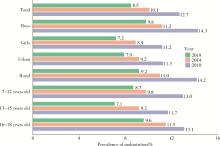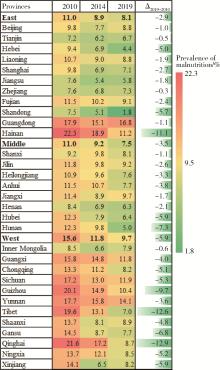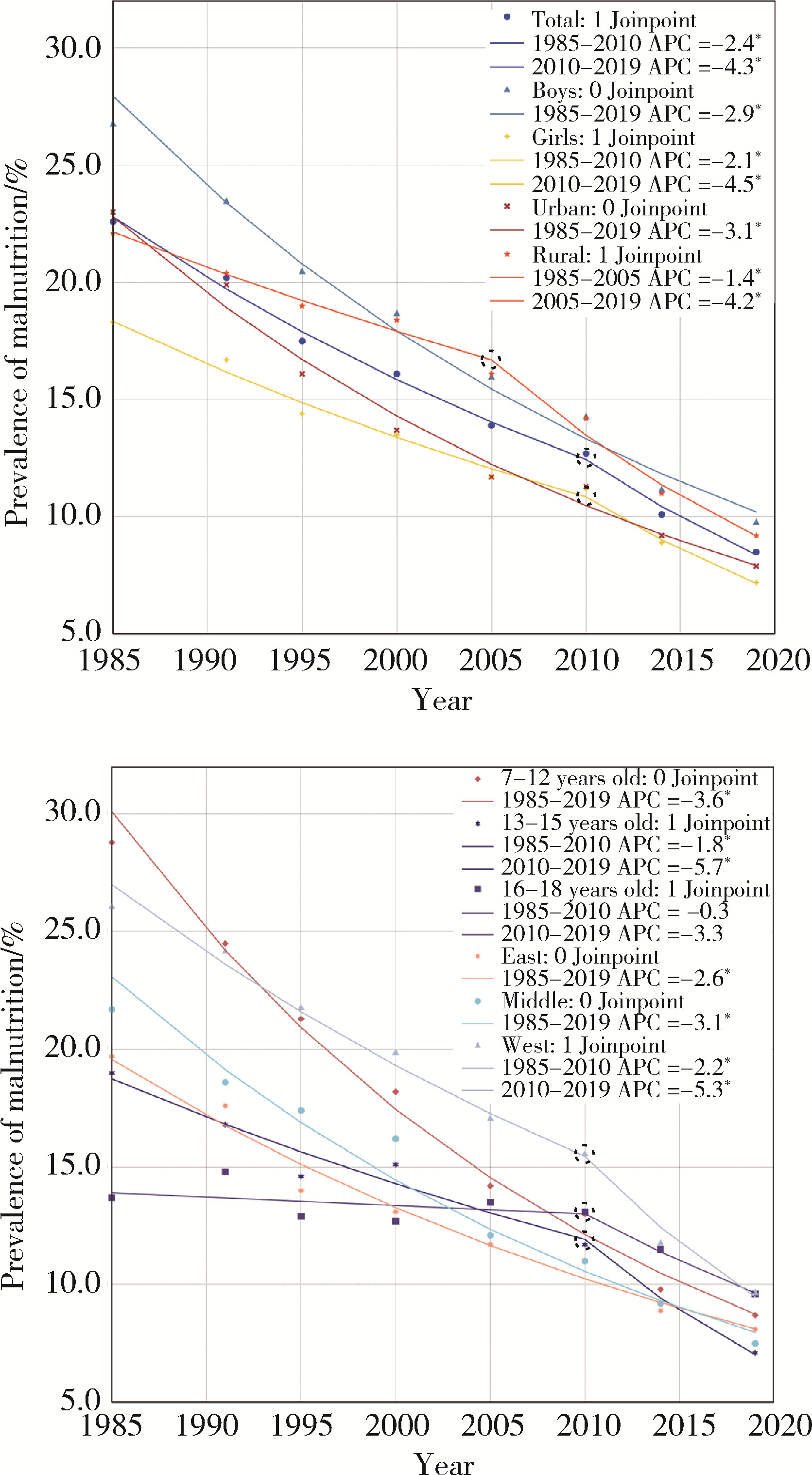Journal of Peking University (Health Sciences) ›› 2023, Vol. 55 ›› Issue (4): 593-599. doi: 10.19723/j.issn.1671-167X.2023.04.004
Previous Articles Next Articles
Assessment of prevalence of malnutrition among Chinese primary and secondary school students and analysis of policy effect during the period of the Program for the Development of Chinese Children 2011-2020
Xiao-jin YAN,Yun-fei LIU,Ning MA,Jia-jia DANG,Jing-shu ZHANG,Pan-liang ZHONG,Pei-jin HU,Yi SONG*( ),Jun MA
),Jun MA
- Institute of Child and Adolescent Health, Peking University School of Public Health, Beijing 100191, China
CLC Number:
- R153.2
| 1 | Young EM . Food and development[M]. Abingdon, Oxon: Routledge, 2013: 36- 38. |
| 2 | United Nations International Children ' s Emergency Fund . The State of the World's Children 2019: Children, food and nutrition: Growing well in a changing world[M]. New York: UNICEF, 2010: 61- 75. |
| 3 | United Nations International Children ' s Emergency Fund. The State of the World's Children 2019: Children, food and nutrition: Growing well in a changing world[R]. New York: UNICEF, 2019. |
| 4 | Akparibo R , Harris J , Blank L , et al. Severe acute malnutrition in children aged under 5 years can be successfully managed in a non-emergency routine community healthcare setting in Ghana[J]. Matern Child Nutr, 2017, 13 (4): e12417. |
| 5 |
Harold A , John H , Bill K . Long term consequences of early childhood malnutrition[J]. Oxford Econ Pap, 2006, 58 (3): 450- 474.
doi: 10.1093/oep/gpl008 |
| 6 |
Black RE , Victora CG , Walker SP , et al. Maternal and child undernutrition and overweight in low-income and middle-income countries[J]. Lancet, 2013, 382 (9890): 427- 451.
doi: 10.1016/S0140-6736(13)60937-X |
| 7 |
NCD Risk Factor Collaboration . Worldwide trends in body-mass index, underweight, overweight, and obesity from 1975 to 2016: A pooled analysis of 2 416 population-based measurement studies in 1 289 million children, adolescents, and adults[J]. Lancet, 2017, 390 (10113): 2627- 2642.
doi: 10.1016/S0140-6736(17)32129-3 |
| 8 | 中华人民共和国国务院. 中国儿童发展纲要(2011—2020年)[EB/OL]. (2011-07-30)[2021-01-05]. https://www.scio.gov.cn/ztk/xwfb/46/11/Document/976030/976030.htm. |
| 9 | 中国学生体质健康调研组. 1985年中国学生体质与健康研究[M]. 北京: 人民教育出版社, 1987: 4- 6. |
| 10 | 中国学生体质健康研究组. 1995年中国学生体质与健康调研报告[M]. 长春: 吉林科学技术出版社, 1997: 3- 4. |
| 11 | 中国学生体质健康研究组. 2000年中国学生体质与健康调研报告[M]. 北京: 高等教育出版社, 2002: 3- 4. |
| 12 | 中国学生体质健康研究组. 2005年中国学生体质与健康调研报告[M]. 北京: 高等教育出版社, 2007: 8- 9. |
| 13 | 中国学生体质健康研究组. 2010年中国学生体质与健康调研报告[M]. 北京: 高等教育出版社, 2012: 4- 5. |
| 14 | 中国学生体质健康研究组. 2014年中国学生体质与健康调研报告[M]. 北京: 高等教育出版社, 2016: 4- 5. |
| 15 | 中国学生体质与健康研究. 中国学生体质与健康监测报告(1991年)[M]. 北京: 科学技术出版社, 1993: 2- 3. |
| 16 | 国家卫生和计划生育委员会. WS/T 456—2014学龄儿童青少年营养不良筛查[S]. 北京: 中国标准出版社, 2014. |
| 17 | 赵志强, 叶蜀君. 东中西部地区差距的人类发展指数估计[J]. 华东经济管理, 2005, 19 (12): 22- 25. |
| 18 |
Kim HJ , Fay MP , Feuer EJ , et al. Permutation tests for joinpoint regression with applications to cancer rates[J]. Stat Med, 2000, 19 (3): 335- 351.
doi: 10.1002/(SICI)1097-0258(20000215)19:3<335::AID-SIM336>3.0.CO;2-Z |
| 19 | 李辉章, 杜灵彬. Joinpoint回归模型在肿瘤流行病学时间趋势分析中的应用[J]. 中华预防医学杂志, 2020, 54 (8): 908- 912. |
| 20 | 中华人民共和国国务院. 九十年代中国儿童发展规划纲要[EB/OL]. (1992-02-16)[2021-01-05]. http://www.wsic.ac.cn/policyandregulation/7666.htm. |
| 21 | 中华人民共和国国务院. 中国儿童发展纲要(2001—2010年)[EB/OL]. (2001-05-22)[2021-01-05]. http://www.scio.gov.cn/xwfbh/xwbfbh/wqfbh/39595/41756/ xgzc41762/Document/ 1664775/1664775.htm. |
| 22 |
Zong XN , Li H , Zhang YQ , et al. Child nutrition to new stage in China: Evidence from a series of national surveys, 1985-2015[J]. BMC Public Health, 2019, 19 (1): 402.
doi: 10.1186/s12889-019-6699-z |
| 23 | 季成叶. 中国乡村学生群体营养不良流行状况20年动态分析[J]. 中国儿童保健杂志, 2009, 17 (1): 11- 14. |
| 24 | 房玥晖, 赵丽云, 于冬梅, 等. 2010—2012年中国6~17岁儿童青少年生长迟缓和消瘦状况[J]. 卫生研究, 2018, 47 (1): 27- 31. |
| 25 | 董彦会, 王政和, 马军. 2005—2010年我国7~12岁学生营养不良流行现状分析[J]. 营养学报, 2016, 38 (5): 431- 437. |
| 26 | 中华人民共和国国务院. 国务院办公厅关于实施农村义务教育学生营养改善计划的意见[EB/OL]. (2011-11-23)[2021- 01-05]. http://www.yueyang.gov.cn/mlzfw/25310/27768/27769/content_638768.html. |
| 27 | 普布卓玛, 索朗卓玛, 李素娟, 等. 西藏2015—2017年农村中小学生营养改善状况评估[J]. 中国学校卫生, 2020, 41 (1): 29-31, 35 |
| 28 | 余闯. 营养改善计划惠及全国3700万农村学生[N/OL]. 中国教育报, (2018-07-04)[2021-01-19]. http://www.moe.gov.cn/jyb_xwfb/xw_zt/moe_357/jyzt_2018n/2018_zt11/zt1811_gz/zt181107_mtgz/201807/t20180704_341921.html. |
| [1] | Chengyue LI, Hao WANG, ALIMUJIANG·Yimiti·tarken. Secular trend in growth of Uygur primary and middle school students aged 7-18 years in Xinjiang from 1985 to 2019 [J]. Journal of Peking University (Health Sciences), 2024, 56(5): 802-808. |
| [2] | Yue WEI,Xi LU,Jing ZHANG,Kun-peng LIU,Yong-jun WANG,Lan YAO. Effect of preoperative carbohydrates intake on the gastric volume and the risk of reflux aspiration in patients positioning in trendelenburg undergoing gynecological laparoscopic procedures [J]. Journal of Peking University (Health Sciences), 2023, 55(5): 893-898. |
| [3] | HUANG Bing, WANG Hong-yuan. Analysis of the development trend and severity of the COVID-19 panidemic in the global world [J]. Journal of Peking University (Health Sciences), 2021, 53(3): 536-542. |
| [4] | Li-ping DUAN,Zhao-xia ZHENG,Yu-hui ZHANG,Jie DONG. Association of malnutrition-inflammation-cardiovascular disease with cognitive deterioration in peritoneal dialysis patients [J]. Journal of Peking University(Health Sciences), 2019, 51(3): 510-518. |
| [5] | DONG Yan-hui, WANG Zheng-he, YANG Zhao-geng, WANG Xi-jie, CHEN Yan-jun, ZOU Zhi-yong, MA Jun. Epidemic status and secular trends of malnutrition among children and adolescents aged 7-18 years from 2005 to 2014 in China [J]. Journal of Peking University(Health Sciences), 2017, 49(3): 424-432. |
| [6] | MAN Sai-li-mai, GUO Yan. Research on the social determinants of malnutrition among children under the age of 5 in China [J]. Journal of Peking University(Health Sciences), 2016, 48(3): 418-423. |
| [7] | SONG Yi, HU Pei-Jin, ZHANG Bing, MA Jun. Secular trends of height among Chinese students aged 17 in 18 ethnic minorities from 1985 to 2010 [J]. Journal of Peking University(Health Sciences), 2015, 47(3): 414-419. |
|
||





